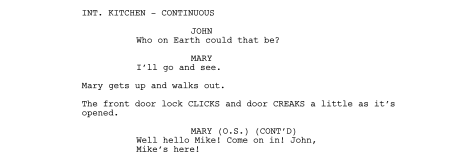- 3-minute read
- 2nd September 2018
How to Format a Screenplay
Do you hear Hollywood calling? Then maybe it’s time to work on that screenplay you’ve been planning. But if you’ve never written one before, where do you start? In this post, we offer a few basic tips on how to format a screenplay. Let us know if you need someone to proofread yours!
How to Format a Screenplay
All scripts follow a set of rules that you need to know if you want to format a screenplay professionally. The key details are:
- A title page with your name and contact information
- Using a 12pt Courier font (the consistent spacing of this font means that each page should amount to roughly one minute of screen time)
- A 1” margin on the top, bottom and right-hand side of the page
- A 1.5” margin on the left of the page to allow space for binding
- Page numbers in the upper right header for each page after the first
Typically, a screenplay for a feature film would be around 90-120 pages. However, scripts for TV or short films are shorter, so the ideal length depends on what you are writing.
The Elements of a Screenplay
Every script should include certain things. The most important are:
Find this useful?
Subscribe to our newsletter and get writing tips from our editors straight to your inbox.
- Scene headings – A scene heading introduces each scene in your script. Each heading should be in all caps and say whether the scene is set inside (INT.) or outside (EXT.), followed by the location and whether it is day or night. For example: EXT. OUTSIDE CITY HALL – DAY.
- Action – A description of what happens in each scene written in the present tense. This should only include things that can be seen or heard, not what characters are thinking or feeling.
- Characters – Introduce the names of characters in your screenplay in all caps the first time they are mentioned in the action. Character names are also used to introduce dialogue so that we know who is speaking, indented 2” from the left margin.
- Dialogue – The words spoken by characters, including when someone is speaking offscreen or in a voiceover. Each line should be indented 1” from the left margin and end 1.5” from the right margin so that it appears in roughly the centre of the page.
- Parentheticals – Notes in brackets that indicate how something is said or what a character is doing while they speak. Parentheticals should be indented 1.5” from the left margin.
- Extensions – Notes given in brackets after a character name when introducing dialogue. The most common are O.S. (meaning ‘offscreen’) and V.O. (short for ‘voiceover’).

In a shooting script, you would also include information about transitions and shots. However, a shooting script is written after selling the initial screenplay (otherwise known as a ‘spec script’).
Screenplay Writing Software
Finally, to make writing a screenplay as simple as possible, you may want to try using software designed specifically for that purpose. These programs will handle the formatting for you, which helps ensure consistency and lets you focus on the writing! There are both paid-for and free programs available, so take a look and see what suits you best.